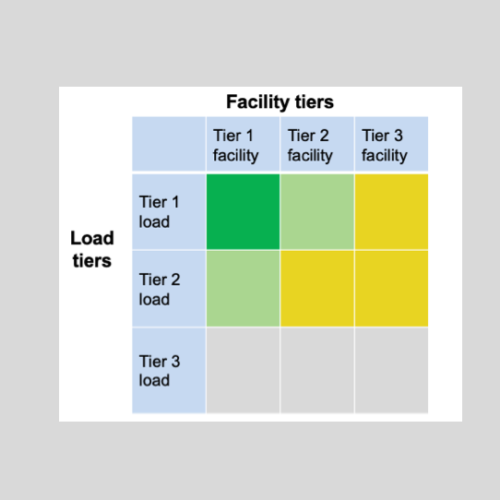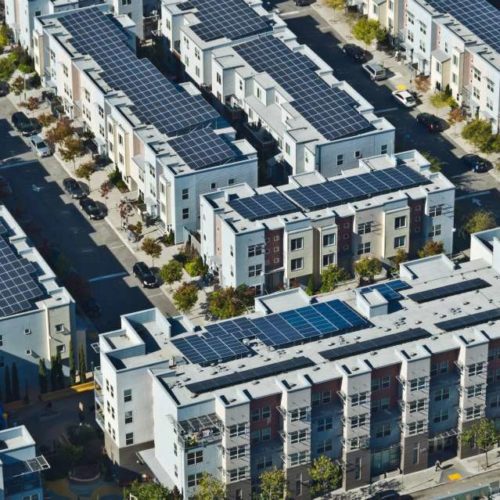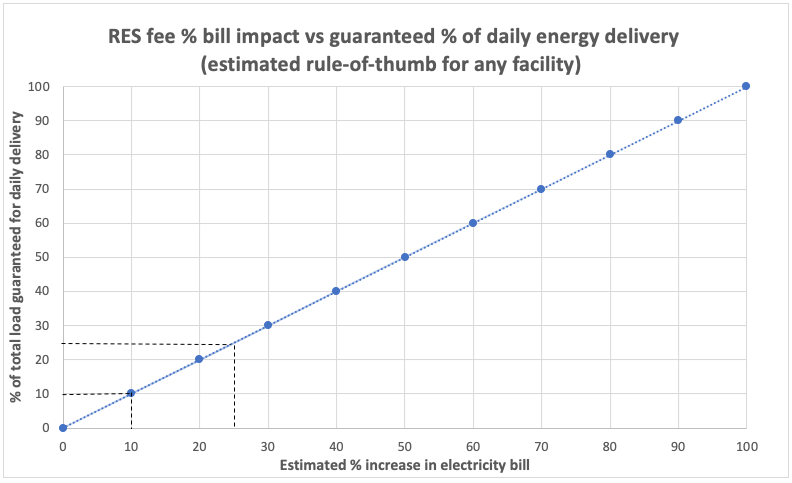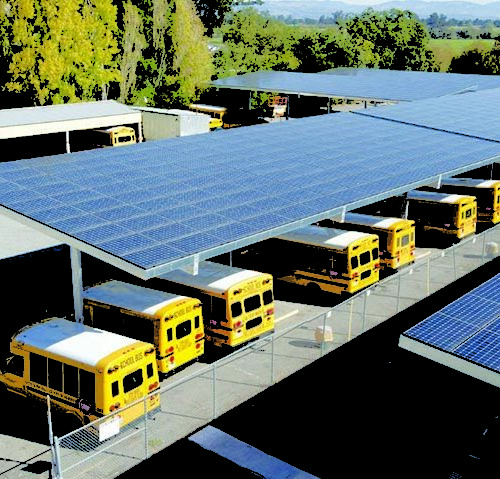The Best Ideas from COP30, the UN Climate Summit in Brazil – 18 December 2025
The Clean Coalition was a partner organization for this webinar, which took place on 18 December 2025 at 10am.
Read More
A market mechanism to finance and expand Community Microgrids
The Resilient Energy Subscription (RES) is a straightforward market mechanism for financing Community Microgrids beyond ratepayer-funded coverage for the most critical loads at critical community facilities (CCFs). This graphic tells the story; more details can be found on this page:

Currently, without active utility cooperation, deploying Community Microgrids is close to impossible; even with a utility partner, there is no guarantee that a Community Microgrid will be deployed, either on time or at all. While the Redwood Coast Airport Microgrid (RCAM) is staging to become the first true Community Microgrid in California, after many years of development, RCAM remains the only example of a true Community Microgrid that is in development within California.
To fill this gap, the Clean Coalition has developed the RES market mechanism, under which customers would pay an additional charge to participate in a Community Microgrid — and we recommend using the estimate from our value-of-resilience methodology, VOR123, to help calibrate the rates that subscribers should be willing to pay.

RES allows any facility within the footprint of a Community Microgrid to pay a simple fee on top of its normal electricity tariff for guaranteed daily delivery of locally generated renewable energy during grid outages, ensuring unparalleled energy resilience. Each individual facility will decide which loads are critical and will procure resilience for those loads via a transparent fee that covers the cost of service (COS) of provisioning such energy resilience from a Community Microgrid.

Under normal grid conditions, facilities will operate with all loads served. Because Community Microgrids are sized to deliver resilience during grid outages of any duration, including over numerous days of low solar production, Community Microgrids will generally deliver far more energy than the RES allocations during grid outages — given that solar production is otherwise always better than the worst-case RES design period.
When there is a shortage of available energy during grid outages, however, a Community Microgrid is obligated to deliver only to RES limits, and any customer reaching its RES limit can be turned off at its meter. RES subscriptions will be offered on a first-come, first-served basis, only limited by Community Microgrid subscription capacity, which of course will expand as subscription waitlists grow.

The figure here illustrates how the different loads in a Community Microgrid should be valued, with the green boxes indicating the most essential loads to keep on. Due to the critical role that Tier 1 facilities play in keeping communities safe and functioning, the COS for serving all Tier 1 loads at Tier 1 facilities (shown in dark green) should be ratebased, similar to how costs associated with the transmission grid are ratebased. Given the societal value of of these Tier 1 Critical Community Facilities (CCFs), it is more than reasonable to ratebase the associated COS for Community Microgrids to a level that they can deliver RES allocations covering Tier 1 loads at Tier 1 facilities — and arguably Tier 2 loads at Tier 1 facilities, too.

To properly value resilience in a Community Microgrid, three basic challenges must be overcome:
RES addresses all these issues, allowing a utility to plan strategically for resilience by aggregating RES allocations as they are contracted by facilities across the Community Microgrid footprint. Beyond Tier 1 facilities, for which the costs of Community Microgrid coverage are socialized, simple market forces determine the additional sizes of Community Microgrids and the additional facilities covered. As Community Microgrids expand, costs and fees will trend lower, and RES fees will be recalculated annually to account for reductions.
RES allows a utility to plan strategically for resilience by aggregating RES allocations as they are contracted by facilities across the Community Microgrid footprint. Once the initial investment of a Community Microgrid for CCFs is made, future investments are based on market demand for resilience. As Community Microgrids expand and cost efficiencies are achieved through learning and economies of scale, RES costs and fees will trend lower, and the RES fees can be recalculated periodically to account for such reductions.
Once an initial Community Microgrid is established for serving the CCFs, the incremental COS for expanding the Community Microgrid via the market-based RES will be relatively low. For the average facility, the Clean Coalition has calculated that each 1% of load that a facility secures via a RES will result in a 1% electricity bill increase, as shown in this chart:

Thus, through a RES, it is feasible for Community Microgrids to be deployed and financed without shifting any costs to non-participants. Importantly, while the RES market mechanism encapsulates the price of resilience for each facility at the COS of the Community Microgrid, the value delivered to each facility is far higher, as evidenced by the VOR123 methodology.

To determine RES requirements for a specific facility, the facility first reviews its historical energy usage and can then either:
For a hypothetical financial institution, we can see that each 1% of load that a facility secures for guaranteed daily energy delivery via a RES will result in a 1% electricity bill increase.
For a bank with typical load tiering percentages of 10% for Tier 1 and 15% for Tier 2 loads (indicated by the hashed black lines), a RES contract for Tier 1 loads only will result in the bank’s electricity cost increasing by only 10%, and reserving for both Tier 1 and Tier 2 loads will result in a 25% increase. Most facilities will contract RES to guarantee coverage for only Tier 1 loads, but each facility can make such decisions for itself.

Facilities with existing solar can reduce RES allocations, because a RES contract will ensure that the facility maintains electricity service during grid outages — from the Community Microgrid. Importantly, the solar will stay active and the self-generation will cover at least a portion of their resilience requirements. Hence, such Community Microgrid subscribers will enjoy uninterrupted self-generated solar while also receiving RES-contracted energy from the Community Microgrid, unless energy availability is low from the Community Microgrid and the RES-contracted energy allocation has been exceeded on a given day.
An example of facilities with existing solar that can subscribe to RES are the solar-only installations planned for the Santa Barbara Unified School District (SBUSD). While some of the SBUSD sites will enjoy unparalleled resilience from Solar Microgrids, the sites with solar only can also benefit from this resilience via the RES.
A potential step forward for Community Microgrids would be the proposal made by the County of Los Angeles, which will diversify the Community Microgrid procurement process, reducing the burden on the IOUs and allowing municipalities to work in tandem to protect critical community facilities (CCFs) and disadvantaged vulnerable communities (DVCs).
A potential Community Microgrid serving multiple adjacent CCFs in East Los Angeles could be funded via the County of Los Angeles proposal — and serve additional facilities via the RES.

In partnership with the County of Los Angeles, the Clean Coalition is conducting a Solar Microgrids feasibility study to determine the possibilities for Solar Microgrids at three County of Los Angeles CCFs. Despite being adjacent facilities with available space to deploy immense levels of solar, current restrictions make it nearly impossible to achieve a Community Microgrid for these CCFs.
As a result, a configuration of three separate Solar Microgrids is the most likely outcome, leaving significant solar siting opportunities on nearby built environments unutilized and missing a big opportunity for increased reliability and resilience to this area. A Community Microgrid can be implemented at this East Los Angeles hub to maximize local solar, reliability, and resilience to vital CCFs and potentially additional nearby facilities.
The latest in clean local energy
Learn about our innovative projects and initiatives on our blog, and see what others are reporting about our important work.
The Clean Coalition was a partner organization for this webinar, which took place on 18 December 2025 at 10am.
Read MoreThis podcast episode of Energy Central's "Power Perspectives" welcomes Craig Lewis, Founder and Executive Director of the Clean Coalition, to explore how local solar and storage can flatten the duck curve, cut costs, and build a more resilient grid.
Read articleThe Clean Coalition presented during this in-person gathering, held on Friday, 5 December 2025 from 3:30–5:00 pm PST at CEC’s Environmental Hub, 1219 State St Suite A, Santa Barbara, CA 93101.
Read More